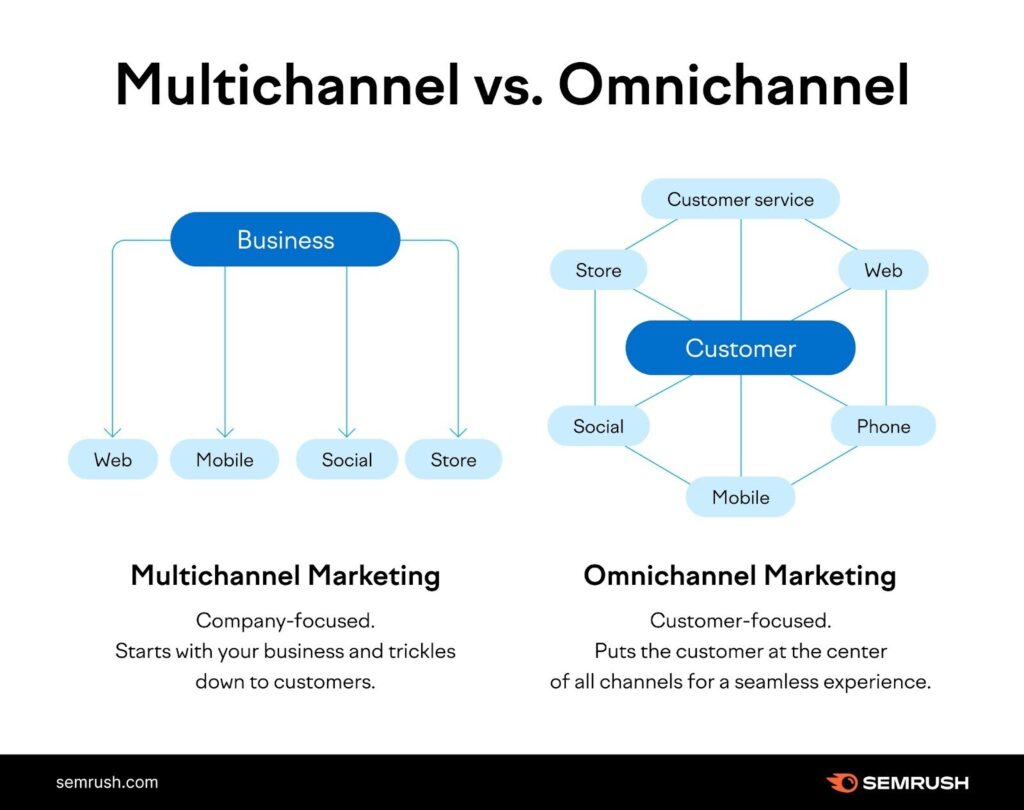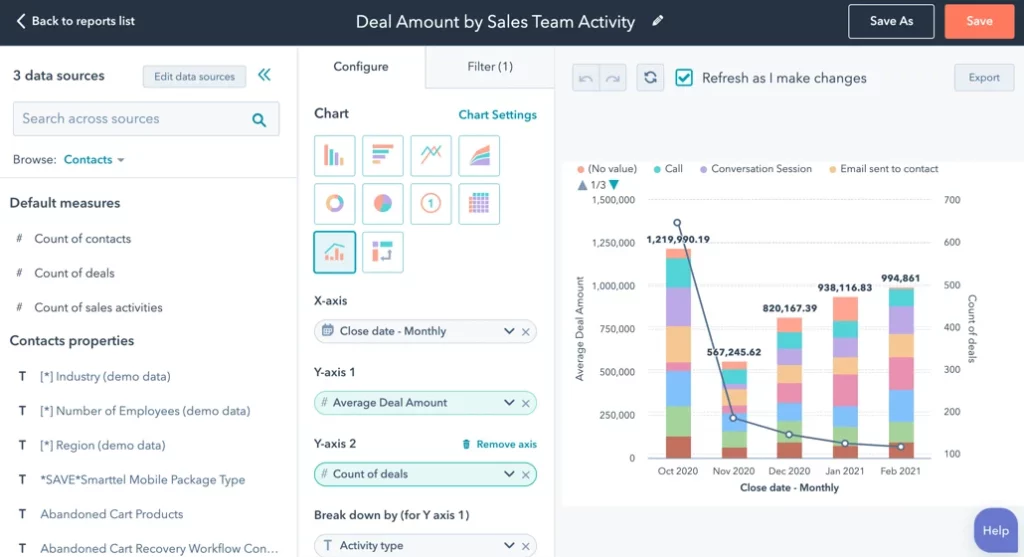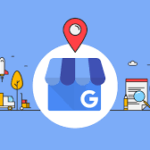In today’s digital era, B2B companies are embracing omnichannel marketing to provide seamless customer experiences across a variety of platforms. This approach integrates multiple marketing channels to create a seamless and personalized journey for both prospects and existing clients.
Omnichannel marketing can sound complex, but it’s not as complicated as it seems. At its root, it’s simply using many marketing channels at once to reach your audience.
We hope to simplify it and give some tangible examples in this blog post. We will delve into the nuances of omnichannel marketing in the B2B realm, exploring its significance, strategies, best practices, and cover an example from one of our clients (we helped them increase their sales by 203% using an omnichannel approach).
What Exactly Is Omnichannel Marketing?
In short, omnichannel marketing is a customer-centric approach to marketing. It involves putting the customer at the center of all of your activities – from social media to the sales process – and communicating a clear and consistent message across the board. It typically involves using multiple channels and platforms to create an omnipresent experience for them.
As we’ll discuss later, the key is a consistent and seamless experience across every touchpoint.

Challenges of Omnichannel B2B Marketing
B2B digital marketing is distinct from B2C in several ways. It involves longer sales cycles, a smaller, more niche target audience, and often requires nurturing high-value clients through personalized relationships. The decision-making process in B2B transactions is complex, typically involving multiple stakeholders, and is driven by logic and financial incentive. Consequently, the digital marketing strategies employed must cater to educating and building trust with potential clients over time through detailed content, comprehensive service demonstrations, and robust engagement platforms.

The nature of B2B marketing creates some hurdles when it comes to omnichannel marketing, largely due to this complexity.
One significant challenge is the integration of various digital platforms and channels to deliver a unified brand message. And aligning internal teams to ensure a consistent customer experience is often a logistical test. The more touchpoints there are, the more complex omnichannel becomes.
However, these challenges are balanced by the opportunity to leverage a wealth of data for deeper customer insights, craft more personalized campaigns, and increase touchpoints that can nurture leads through the sales funnel more effectively.
The nature of B2B transactions also means that opportunities in omnichannel marketing can lead to substantial rewards. The ability to deliver targeted content through the right channels at the right time can significantly influence the purchasing decisions of businesses.
Several B2B industries are seeing great results thanks to an omnichannel approach:
- Many in the software-as-a-service (SaaS) industry utilizes webinars, live chats, social media engagement, and email nurturing campaigns to educate and convert leads.
- In manufacturing, companies are combining traditional sales tactics with digital catalogues, mobile applications, and virtual reality tours to showcase their products and services.
- Professional services firms are leveraging thought leadership through white papers and case studies distributed across different social channels, email, and industry forums to build credibility and generate leads.
Building an Effective Omnichannel Strategy for B2B
Creating an omnichannel marketing strategy in a B2B environment is a complex task that demands a deep understanding of your audience, meticulous planning of your marketing channels, astute use of data and analytics, personalized content delivery, and a synergy between sales and marketing efforts.
Understanding Your Target Audience
We say this in every blog post we write, but any successful marketing campaign starts with this.
Crafting detailed buyer personas is crucial. These personas represent your ideal customer base and are based on real data about customer demographics, behavior patterns, motivations, and goals. The more detailed your personas, the better you can tailor your omnichannel strategy to the specific needs, interests, and challenges of your prospects, ensuring relevancy and effectiveness.
Once you have a persona, you need to map their journey. Journey mapping is a visual representation of every experience your customers have with you. It helps in understanding the many interactions customers have with your brand before they make a purchase. By mapping the customer journey, you can identify key touchpoints where targeted interventions can be made to move prospects through the sales funnel.
Integrating Different Marketing Channels
Start by identifying the key marketing channels for your audience and personas based on their maps / journeys. Not all channels will be right for your business. The key is to identify where your buyers are spending their time and how they prefer to engage. For B2B, LinkedIn, email marketing, webinars, and trade websites are often key channels, but this can vary greatly by industry and audience. You need to also consider your offline channels, too.
Once you’ve chosen your channels, the key is staying consistent across them all. Consistency is the bedrock of effective omnichannel marketing. Your brand’s message should be coherent whether a customer engages with an email, a social media post, or a webinar. Consistency in tone, messaging, and visual branding reassures clients of your reliability and professionalism.
Leveraging Data and Analytics
Data collection and analysis are what make personalized, targeted marketing possible. By collecting data across all channels, you can gain insights into customer behaviors, preferences, and pain points, allowing you to optimize your marketing efforts continuously.
But the key is making sure you’re collecting everything and are able to analyze it efficiently. It’s easier said than done.
CRM and marketing automation tools will be your best friends here. They can handle vast amounts of data, help manage customer interactions, and automate repetitive tasks. They allow for more personalized, timely interactions with potential customers and provide valuable insights into the effectiveness of marketing strategies.
Personalization and Segmentation
Personalization is not just about addressing a customer by name; it’s about delivering content that resonates with their specific industry, business size, and stage in the buying cycle. This level of personalization requires a deep understanding of your audience segments, so make sure you took your time building out personas and journey maps.
If you have really clear segments, you may consider rolling out an ABM play as a piece of your omnichannel marketing strategy. ABM is a strategic approach where marketing and sales treat individual prospect accounts as markets in their own right—a perfect fit for B2B. This approach focuses resources on a set of target accounts within a market and employs personalized campaigns designed to resonate with each account.

Sample ABM Omnichannel Campaign Dashboard
Using omnichannel marketing is the key to a successful ABM campaign. You want to be in front of your prospect offering them value everywhere they turn (without overwhelming them). For example, you might target your list of accounts with:
- Simple brand-focused display ads throughout the internet
- Case study and whitepaper-download ads on LinkedIn
- Brand video ads on Facebook / Instagram
- Bi-weekly emails focused on thought leadership around industry developments
- Physical mail once a month with branded gifts included
When each of these aspects is valuable and they’re all consistent in tone and messaging – your target accounts will have a hard time ignoring you.
A successful omnichannel strategy in B2B marketing hinges on an interplay between understanding the customer, utilizing the right channels, and leveraging technology to deliver a personalized and seamless experience. By focusing on these areas, B2B companies can not only meet but exceed the evolving expectations of their clients.
How We Helped CRIF Increase Sales by 203% with Omnichannel Marketing
We recently had the opportunity to work with business solution provider CRIF. Facing low brand awareness and disjointed brand identity post-expansion, CRIF approached us needing help growing awareness in the Asian market where they had recently acquired some local entities.
We started with targeted persona research to gain a better understanding of their audience. Once we knew our target, we reimagined their approach to organic social and put together a cohesive social media content strategy. We coupled their organic social overhaul with strategic LinkedIn content and optimized Google Ad campaigns, enabling CRIF to cultivate a unified and authoritative brand image that resonated with their audience across multiple platforms.

The results were huge – a 40% increase in social media followers and a 63% decrease in cost per acquisition on top of their 203% increase in sales.
Check out the full omnichannel marketing case study here.
Embrace the Future of B2B with an Omnichannel Approach
From understanding the nuances of B2B buyer behaviors to the integration and personalization of various marketing channels, the journey to omnichannel proficiency is complex yet deeply rewarding for brands who get it right. As digital marketing continues to evolve, the businesses that will thrive are those that embrace the omnichannel approach, blending technology, data, and content into a seamless narrative that speaks directly to the heart of their customer’s needs and challenges.

 Hubspot
Hubspot



